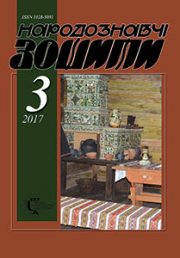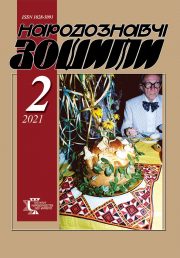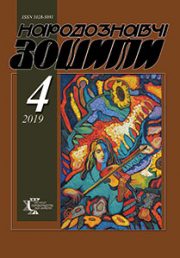The Ethnology Notebooks. 2021. # 2 (158), P. 435—439
УДК 903.23.02 : 069(477.52-21Конотоп)](045)
DOI https://doi.org/10.15407/nz2021.02.435
Anatoliy SHCHERBAN
- ORCID ID: https://orcid.org/0000-0002-9530-6453
- Doctor of Sciences in Culturology,
- Ph. D. in History,
- Head of the Department of History, Museology
- and Heritage Study, Kharkiv State Academy of Culture,
- e-mail: kozaks_1978@ukr.net
Yevgen OSADCHIJ
- ORCID ID: https://orcid.org/0000-0002-9143-110X
- Ph. D. in History,
- Researcher at Department of Nuclear Physics,
- Institute of Applied Physics of
- National Academy of Sciences of Ukraine,
- e-mail: osadchij.75@gmail.com
«TROICHATKY» — VESSEL FROM THE HOLDINGS OF THE KONOTOP MUSEUM
Problem statement. Products that were specially made in Ukraine for rituals, which we know from the publications of ethnographers of the last quarter of the nineteenth — first third of the twentieth century remain insufficiently studied. «Troichatky»are one of their little-studied types of clay vessels. Until recently, only one such vessel from Slobozhanshchyna has been investigated, and another has been recently discovered. Given the steady interest in the ritual culture of the Eastern Slavs, the introduction of information about the newly discovered «Troichatky» into scientific circulation is considered relevant.
Purpose of the paper: characteristics of the «Troichatky» glass from village. Kozatske of the Konotop district of the Sumy region and its comparison with other currently known vessels of this type from the territory of modern Ukraine and the Russian Federation.
The methodological basis of the study is the principles of historicism, systematics in combination with historical-comparative, comparative-ethnographic and microhistorical methods.
Results. The vessel studied in the article entered the holdings of the O.M. Lazarevskyi Konotop City Local Lore Museum in 1987 after it was found in an abandoned house. The product consists of three miniature pot-shaped glasses, connected in the lower parts by pieces of clay, to which the lower edges of handles are glued. Holes are punctured through the connection, through which fluid can flow between the vessels. There is no information about the owners and how to use this product. But after mapping the places where there is information about the manufacture or use of «Troichatky», it was found that in Ukraine they are located almost in a straight line along the modern northeastern border. This area is featured by active contacts of Ukrainians with Russians who lived in compact groups next to each other. Vessels with similar parameters are also known in the regions of the Russian Federation remote from the Ukrainian border. This gave grounds to hypothesize that this category of tableware was included in the range of pottery of the border population due to Russian influence or was made by Russian potters. The product from village Kozatske can be dated to the late 19th — first half of the 20th century.
Keywords: the village of Kozatske, «trоichatky»-vessel, wedding ceremony, Russian influence.
REFERENCES
- Sokolovskij, L. (1883). Potters in the Kupyansk district in 1880. Proceedings of the Сommission for the Study of Handicrafts of the Kharkov province (Issue ІІ, pp. 33—57) [in Russian].
- Sumcov, N.F. (1902). Essays on folk life (From an ethnographic excursion in 1901 in the Akhtyrka district of the Kharkov province). Collection of the Kharkov Historical and Philological Society (Vol. 13); Proceedings of the Kharkiv preliminary committee on the arrangement of the XII archaeological congress (Vol. ІІ). Har’kov: Tipo-Litografija «Pechatnoe delo» [in Russian].
- Scherban’, O. (2015). The unique wedding receptacle of Slobozhanshchyna — «cups-triychatky». The Ethnology notebooks, 4, 984—987 [in Ukrainian].
- Kalinin, A. (2004). Russian and foreign vessels with secrets. Moskow: Granica [in Russian].
- Mashkin, A. (1863). Customs and rituals of the common people in the town of Oboyan. Proceedings of the Kursk Provincial Statistical Committee, 1, 484—505 [in Russian].
- Plotnikova, I. (2000). Cup-«trojka». Science and life, 12. Retrieved from: https://www.nkj.ru/archive/articles/5217/ (Last accessed: 10.12.2020) [in Russian].
- Nomis, M. (Ed.). (1864). Ukrainian proverbs, sayings and so on. S.-Peterburh: v drukarniakh Tyblena y komp. y Kulisha [in Ukrainian].
- Lytvynova-Bartosh, P. (1900). Wedding ceremonies and customs in the village of Zemlyanka, Hlukhiv district, Chernihiv region. Materials on Ukrainian-Russian ethnology, 3, 71—173 [in Ukrainian].






